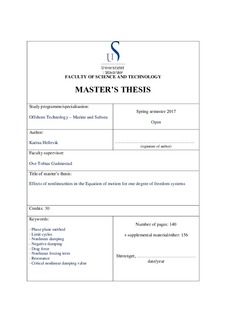| dc.description.abstract | Most natural phenomena in the world have a nonlinear behaviour. If systems are to be described by linear equations they must follow the superposition principle. The superposition principle, consisting of additivity and homogeneity, states that the response caused by several inputs are equal to the sum of each input separately. Even though a minimal amount of systems in the world follow this principle, linearization of systems is widely used. The classical thoughts that the world could be described linearly were not disputed until the late 19th century.
Dynamical systems describe how all points of the system evolve with time. Most nonlinear systems cannot be explicitly solved, so phase diagrams are widely used. Phase diagrams map the velocity and position as time increases, making it possible to investigate how the system travels after some time. Trajectories with different initial values also tells us how sensitive the system is to its starting values.
This thesis has been divided into two parts. Part I consists of chapters 1-4, while part II consists of chapter 5-9.
Chapter 1 gives an introduction briefly describing important terms and the history of nonlinearity in engineering. Chapter 2 gives a description of an unforced, linear dynamical system with different values of damping, using the method of the phase plane. In chapter 3, a linear forcing term is added to the system, and limit cycles are explained.
The Pendulum equation, van der Pol equation and the Morison equation, which all describe known nonlinear systems are presented in chapter 4.
Part II of this thesis consists of a parameter study of an equation of motion with nonlinearity in either the forcing or the damping term.
Chapter 5 gives the presentation of what is termed the “base-case system”, which is an undamped system subjected to a nonlinear forcing term representing the drag force from the Morison equation. The parameters are varied separately to look at their effect on the system.
In chapter 6, linear, constant damping is added to the base-case system and some selected systems with varied parameters from chapter 5. The results are as expected, with decaying amplitudes due to the damping. The systems mass parameter is also varied to get systems close to and at resonance. These systems have a behaviour similar to the results obtained from the van der Pol equation in chapter 4.
Chapter 7 and 8 look at systems with a nonlinear damping term. In chapter 7, the homogenous base-case system is investigated, as well as systems with some degree of resonance. Critical values of the nonlinear damping parameter are found, where negative damping overtakes the systems. These critical values are different for each system. In chapter 8, a linear forcing term is added. The results from this chapter show that the critical values of the nonlinear damping parameter are the same with force added.
In chapter 9, limit cycles are found for the base-case system with linear, constant damping and nonlinear forcing. The limit cycles are found for systems with the mass parameter varied to make the systems have some degree of resonance. As the damping is linear and constant, and some trajectories with initial conditions inside the limit cycle increase their amplitudes, it is concluded that the drag force from the Morison equation will to some degree work as negative damping.
The thesis ends with a summary of conclusions and suggestions for further work within this subject.
This thesis consists of a great deal of figures, plotted in Matlab. To make the figures easily readable the size of each diagram is rather large. This causes the thesis to be of significant length. To make it lighter, the presentation of the separate diagrams in chapter 7 and 8 is put into Appendix C and D respectively.
Keywords:
- Phase plane method
- Limit cycles
- Nonlinear damping
- Negative damping
- Drag force
- Nonlinear forcing term
- Resonance
- Critical nonlinear damping value | nb_NO |

